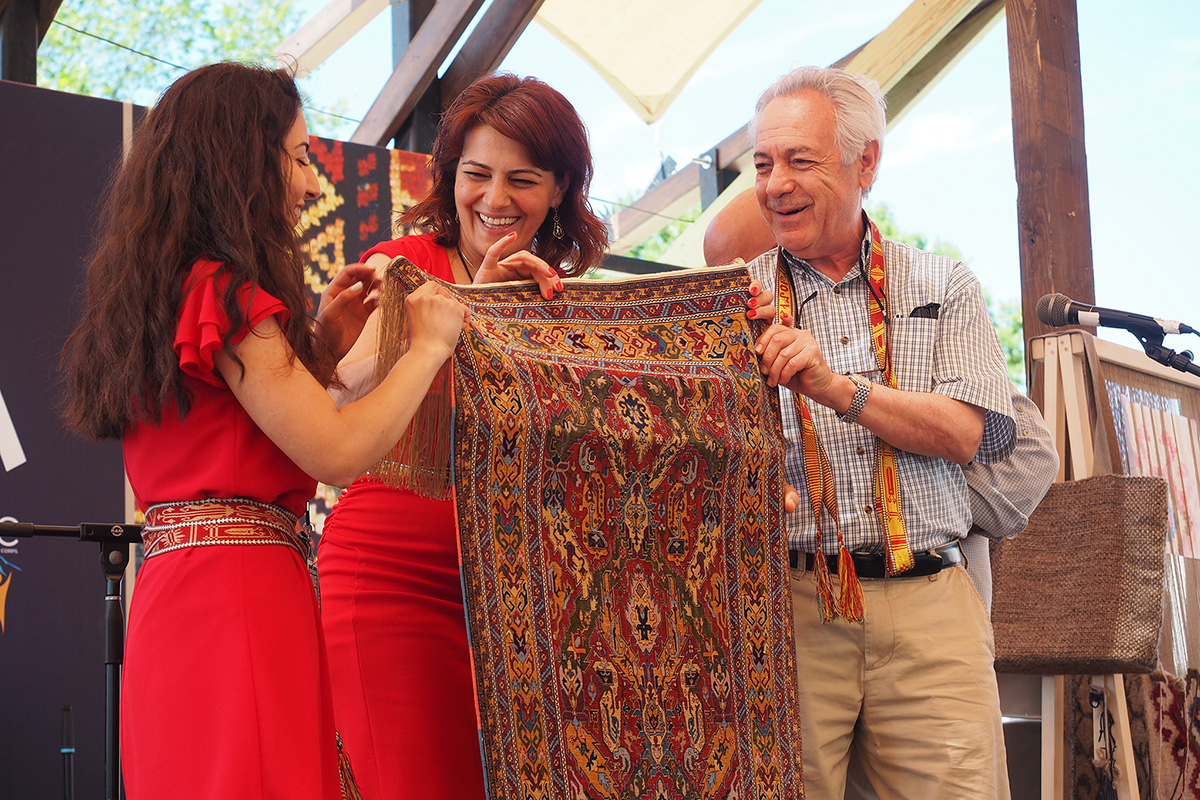The Rug Fell on Her Head

Weavers Diana Hovhannisyan and Ruzanna Torozyan along with presenter Levon Der Bedrossian show off the completed rug on the Hyurasenyak Stage at the 2018 Smithsonian Folklife Festival. Photo by Julie Byrne, Ralph Rinzler Folklife Archives
Shortly after the last piece of fringe on the silk-woven rug was snipped off from its loom, the rug fell on her head—a ceremonial rite of passage often compared to cutting the umbilical cord after giving birth. It marks the female transition from girl to woman.
“In Armenian we say glkhin ynkav: it fell on her head. If the carpet falls and covers her head and face, like a veil, within the next year or so she will get married,” explains Hratch Kozibeyokian, a third-generation weaver who studies the symbolic imagery behind Armenian textiles.
Kozibeyokian, along with other Armenians involved in sustaining and reviving ancient Armenian weaving traditions, led a demonstration on the Armenian carpet cutting ceremony during the last weekend of the 2018 Folklife Festival. They revealed the symbolism and rigorous process behind this communal undertaking, from setting up the loom and tying the first knot to cutting the last piece of yarn.

The silk rug they presented was the second in a series of three that had been woven in Yerevan, Armenia, as part of a training program at the Folk Arts Hub Foundation. Founder Levon Der Bedrossian co-presented the session on the National Mall, sharing the technique and challenges behind the art of silk weaving.
“The silk is a magical phenomenon,” he said. “If you just think, it starts from a moth. Since it is a subtle material to work with, the process is very difficult, requiring a lot of patience and dedication.”
That doesn’t mean hours and weeks. We are talking months and years—for one rug. Festival participant Diana Hovhannisyan worked on the rug displayed at this cutting ceremony for about fourteen months, along with her other colleagues. Unlike the first rug in the series, which had about 600 hand-tied knots per square inch, this one consisted of 840 knots. The third, which Hovhannisyan is currently working on, has approximately 1,080 knots per square inch. That’s dedication.
Camera: Shaun Weber, David Barnes, Emma Cregan, Hannah Luc, Albouri NDiaye, Charlie Weber
Interview and editing: Kaylie Connors
The participants dedicated the ceremony to the American people as a gesture of gratitude from Armenians. It was the one chance visitors had, during the two-week Festival, to experience this rite of passage, giving them a whole new spin on the weaving tradition and its rituals.
But why is it a female and not a male rite of passage?
According to Kozibeyokian, Armenian girls are traditionally exposed to the craft from an early age, observing and assisting their mothers and grandmothers weave carpets, belts, blankets, and other textiles. When a young girl decides to do her first weaving all by herself from beginning to end, her father builds a loom for her, places the warp (longitudinal section), and ties the first foundation. Once she completes the rug (or karpet, a carpet without pile), her father cuts the remains of the foundation that he tied. Traditionally, the completed rug represents the girl’s first accomplishment in her life, preparing her to face the world.
If her mother and grandmother are happy with the finished result, they invite friends and family to their home for a day-long celebration filled with song, poetry, and dances. During the ceremony, when the time comes for the father to cut the rug, the girl sits on a chair under the loom (as seen in video) waiting for the rug to, hopefully, fall on her head. If the weaver happens to be older and is already married with children, then she would invite another female friend, who is also married but doesn’t have a child, to sit under the loom. If the rug falls on her friend’s head, then she will have a baby.

This cutting ceremony and numerous other traditional Armenian weaving practices have been passed down through multiple generations both for home use and to earn a livelihood. Despite the male-dominated commercial side of the weaving industry, female entrepreneurs, such as Ruzanna Torozyan of Goris Women’s Development Resource Center, have succeeded in forging a path and running their own establishments. Torozyan, another Festival participant who took part in the cutting ceremony, founded this co-op as a way to create income opportunities for rural women. They, in turn, are able to pass down their weaving knowledge while reviving and developing local crafts. Not only do they shear the sheep, wash the wool, spin the yarn, and weave the textiles, but they teach and sell their craft, creating unique pieces that combine traditional and contemporary designs.
At the Folklife Festival, visitors developed a new appreciation for these textiles. Not only did the presenters and participants bring awareness to the importance of the ancient Armenian weaving heritage, but they were able to recreate a ceremony that captured the essence of intergenerational social interaction.
As their celebration came to an end in a culmination of song, poetry, and apricots flying through the air, Kozibeyokian cheerfully proclaimed, “This is just a small taste of what Armenian folklife is about!”

Micaela A. Nerguizian is a production consultant in the performing arts and intern at the Smithsonian Center for Folklife and Cultural Heritage. She is completing her graduate degree at the Middlebury Institute of International Studies, with a focus on cultural diplomacy and international education. As the great granddaughter of Armenian rug designer Bedros Mozian, writing this piece inspired her to journey back into her family’s history.

